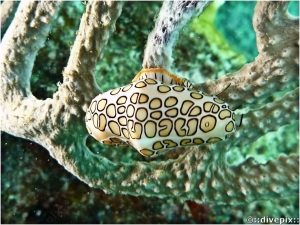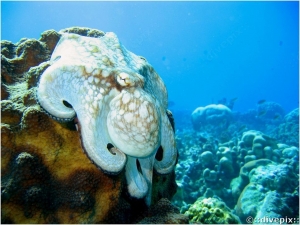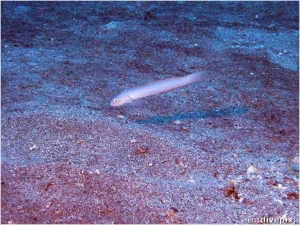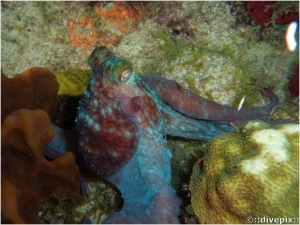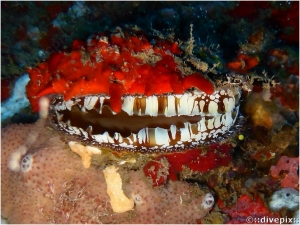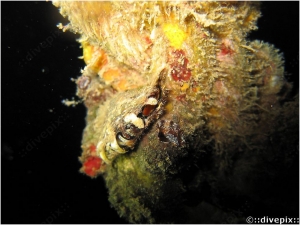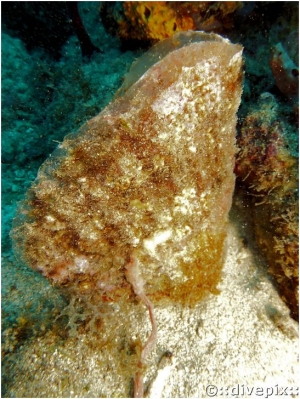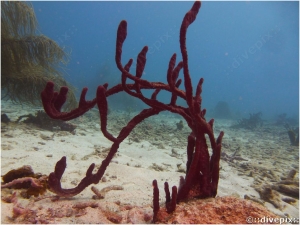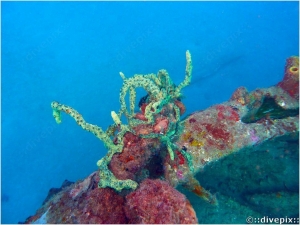




Eric H. Biass
Saturday, 09 February 2013 14:07
Flamingo Tongue
| Aspect: | - |
| Population: | Common, but density very variable from one year to another. |
| Notable feature: | Distinctive pair of smal dark dots on lower lip, but total lack of dark spots along base of dorsal spine differentiates it from the similarly sized Graysby, or larger Red and Rock Hinds. |
| Environment: | Typically devour gorgonian corals with, as can be seen on these picture, devastating effects. |
| Behaviour: | - |
Published in
Gastropods
Tagged under
Thursday, 07 February 2013 18:31
Caribbean Reef Squid
| Aspect: | Oblong body of varying mottled colours (predominantly white and light brown) with white dots on the back. Head is preceded by tentacle-like arms with rows of suckers on their undersides, while a pair of wing-like triangular fins run from either side of the body, from the back of the head to the rear of the pointed body. |
| Population: | Common, especially at night, tend to have their "corners". |
| Notable feature: | Has the ability to dramatically change change colour patterns, sometimes several times in a second, which makes it look very "electric". |
| Environment: | Reef. |
| Behaviour: | Not too wary, especially if initially approached head-on. |
Published in
Cephalopods
Tagged under
Wednesday, 06 February 2013 18:01
Hovering Dartfish
| Aspect: | Totally pale body with slightly tinted dorsal and anal fins |
| Population: | Not very common. |
| Notable feature: | Small intermitent bright line running from eye to gill. |
| Environment: | Generally seen hovering over its u-shaped burrow in sandy bottom. These were photographed at a depth of 40 metres. |
| Behaviour: | Will dive into it u-shaped burrow in the sand if approached too closely. |
Published in
Gobies
Tagged under
Sunday, 03 February 2013 14:39
Caribbean Reef Octopus
| Aspect: | Constantly and abrubptly changes the colour of its mottled coat when approached, with a combination of brown, blue, green and turquoise, but when at rest tries to blend in its background. |
| Population: | Common, but only seen at night. |
| Notable feature: | A sure way of distinguishing Octopus birareus from the more common, but larger, Octopus Vulgaris is the total absence of darker rings around its tentacle suckers. |
| Environment: | Never seen in daytime. Creeps out of its recess to hunt. It is a great bivalve, crustacean and gastropod predator in particular. |
| Behaviour: | Very wary. |
Published in
Cephalopods
Tagged under
Saturday, 02 February 2013 16:57
Atlantic Thorny Oyster
| Aspect: | All is usually seen of Spondylus americanus is the typical shape of two clam-like half shells (called valves) covered in algae or other neighbouring organisms like sponges for better deception and, when open, a white-spotted brown mantle. If they were to be seen uncamouflaged, the valve surfaces would reveal amazing flattish, sharp-edged spines growing radially and horizontally with some overhanging the edges of the valves (as can be seen on some of these photographs). |
| Population: | Common, but requires an exercised eye to spot, particularly when shut. |
| Notable feature: | Brown mantle with white spots. |
| Environment: | Atop rocks, on the side of boulders, wreck surfaces or even old, unmoved, mooring lines as evidenced here. |
| Behaviour: | Will promptly shut if approached too closely (it has a couple of "eyes" made of photosensitive cells to detect a shadow cast by an approaching predator - typically an octopus). Feeds on plankton. |
Published in
Bivalves
Tagged under
Saturday, 02 February 2013 16:48
Atlantic Pearl Oyster
Published in
Bivalves
Tagged under
Saturday, 02 February 2013 16:07
Amber Penshell
| Aspect: | Looks like a large mussel, the pointed tip of which is buried in the sand. Generally covered in algae and concretions, so difficult to assess a real colour. |
| Population: | Not abundant, but not rare either. |
| Notable feature: | Upper edge extremely thin and delicate, translucent |
| Environment: | Usually found on coral sand bottoms. |
| Behaviour: | Like all shells, will close if felt challenged. |
Published in
Bivalves
Tagged under
Saturday, 02 February 2013 15:54
Scattered Pore Rope Sponge
| Aspect: | Brown to purple (generally, but also red and mustard-green) fairly-rigid and irregularly shaped rope-like structure shooting a few inches out of the ground before eventually forking out branches, and finally drooping down under the laws of gravitation only to curve upwards again. Branch tips are often flattened. |
| Population: | Common. |
| Notable feature: | As the name indicates, the rimmed pores (in fact the excurrent openings) look like semi-recessed pop-rivet heads randomly distributed along the branches, which distinguishes it from Row-Pore Rope Sponge (q.v.). Close-up of a broken branch below reveals the species' porous structure. |
| Environment: | As pictures herewith show, can grow from almost any substrate offering a suitable base for the development of a strong encrusting platform. |
| Behaviour: | - |
Published in
Sponges
Tagged under
Saturday, 02 February 2013 15:02
Green Finger Sponge
| Aspect: | Long (longer than finger length) thin and soft green branches growing in convoluted bushes. |
| Ppuulation: | Common |
| Notable feature: | Favourite habitat for Golden Zoanthid colonies (q.v.) |
| Environment: | Usually found in open waters, around and on wrecks, even at depths of 40 metres. |
| Behaviour: | - |
Published in
Sponges
Tagged under



